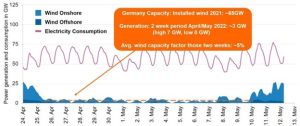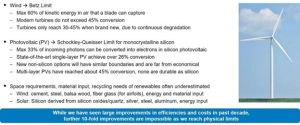It is time to talk about “Capacity Factors”

In electricity generation, capacity factor, utilization, and load factor are not the same.
A lot of confusion exists in the press and certainly in politics, and even amongst “energy experts”, about using the term “capacity factor”. It may be excused, since the distinction made in this article became only relevant with the penetration of variable “renewable” energy, such as wind and solar, in our energy systems.
- Worldwide average solar natural capacity factor (CF) reaches about ~11-13%. Best locations in California, Australia, South Africa, Sahara may have above 25%, but are rare. (see www.globalsolaratlas.info, setting direct normal solar irradiance)
- Worldwide average wind natural capacity factors (CF) reach about ~21-24%. Best off-shore locations in Northern Europe may reach above 40%. Most of Asia and Africa have hardly any usable wind and the average CF would be below 15%, except for small areas on parts of the coasts of South Africa and Vietnam. (see www.globalwindatlas.info, setting mean power density)
Natural capacity factors in Europe tend to be higher for wind than for solar. Wind installations in Northern Europe may reach an average of over 30% (higher for more expensive offshore, lower onshore) but less than 15% in India and less than 8% in Indonesia. Average, and the emphasis is on average, annual solar PV capacity factors reach around ~10-11% in Germany, ~17% in Spain, ~25% in California, and may reach 14-19% in India, but they reach less than 15% in Indonesia’s populated areas. Carbajales-Dale et al. 2014 confirm higher capacity factors for wind than for solar; they estimate global average wind capacity factors to be around 21-24% and solar around 11-13% (see figure above).
The figure further below illustrates a two week period in May 2022 (when I wrote this chapter of our book on capacity factors), where the average wind capacity factor reached only ~5% for ALL German wind installations (on- and offshore).
To avoid confusion, I try to use “natural capacity factor” in my writing wherever possible.
- The “natural capacity factor (CF)” is the % of the maximum possible output of the “power plant” (coal, gas, nuclear, solar, wind, hydro, etc) achieved under the natural conditions of the site, assuming no operational or technological failures or outages.
- I define “utilization” as the % of the power plant’s workable capacity used on average over the year, which is only reduced because of technological, operational, economical outages or curtailments… completely independent of the CF.
- The “net load factor” – in my definition – is then the product of natural capacity factor x utilization.
Thus, when we speak of the natural capacity factor, we are only referring to the nature-derived capacity factor, not the technological or operationally driven “utilization” (often referred to as uptime, plant load factor, or PLF). In other words, when technology fails, or a power plant is turned off on purpose, this will reduce the utilization but not the natural capacity factor.
As mentioned, the natural capacity factor is due to the site, not the solar PV installation. Thus, even a perfect PV material still needs to deal with natural capacity factors with an annual average of 10-25%, not counting for other losses from conditioning, transmission, balancing, or storing highly intermittent sources of electricity (Schernikau and Smith 2021).
The press has mentioned several times that coal or gas have capacity factors of 60% or less on average. This is at best misleading, more likely knowingly wrong for political reasons. However, such a number is not the nature-derived capacity factor; it is the utilization which declines with higher penetration of wind and solar and contributes to electricity system cost increases.
Utilization never should and cannot be compared to natural capacity factors; they are very distinct. Conventional power plants have near 100% natural capacity factors, but their operational and technological utilization often falls significantly below 90% also, but not only, because of the priority given to wind and solar in the system. Because of their high CF, the net-load factor is only slightly lower than utilization for a convention power plant.
Because utilization of wind and solar is often near 100%, their net-load factor is often only slightly lower than their natural capacity factor.

Figure: Germany’s wind generation 25 April to 10 May 2022 during a 2-week wind lull
Source: Agora 2022, Figure 10 in Book “The Unpopular Truth… about Electricity and the Future of Energy”, www.unpopular-truth.com
Needless to say, the natural capacity factor of wind and solar (even for hydro, because of natural river flows) cannot be predicted or guaranteed for any given time frame. The natural capacity factor can be estimated on an annual basis but still varies widely even annually (see Europe in 2021) and is very erratic, sometimes for days and weeks reaching near 0% for wind and solar even in top locations.
Thus, natural capacity factors worldwide are a direct result of the location of the wind or solar installation; they do not in any way depend on and cannot be influenced by the technology employed. The last point is important… no technological advances can change the natural availability of wind, solar, or river flows and therefore influence the natural capacity factor for a given installation. Technology CAN and WILL improve how much usable electricity you get out of the natural input product (wind, solar, river flow, gas, coal, uranium, etc)… this is called conversion efficiency and their limits are discussed further below.
Since the easy locations have already been “used up”, one can expect average natural capacity factors to decline over time… contrary to what Net-Zero plans assume (see International Energy Agency (IEA), McKinsey & Company, or International Renewable Energy Agency (IRENA)).
- For a photovoltaic (PV) park, the natural capacity factor CF depends entirely on the intensity and duration of the sunlight which is affected by seasonality and cloudiness, day and night, and the ability to maintain the PV panel surface’s transparency, e.g., dust in the Sahara or snow in winters.
- Wind farms’ natural capacity factors depend on the site’s wind speed distribution and the saturation speed of the wind turbine. The CF of a wind turbine is determined by the number of hours per year in which the wind farm operates at or above the saturation wind speed (Smith and Schernikau 2022). If the design wind saturation speed is set low, e.g., 4-5 m/s, the wind farm produces little energy, even for high capacity factors. Typically, wind saturation speeds are 12-15 m/s.
It now becomes obvious why the installed capacity needs to be much larger for wind and solar than for dispatchable power such as nuclear, coal, gas, or hydro. This significant relative increase in energy generation capacity to produce the same available, but unpredictable, energy output is coupled with a significantly higher raw material input and energy input factor for variable “renewable” energy which must be offset from any fuel savings.
#Germany is a good example: Total installed power capacity more than doubled in the past 20 years, essentially all consisting of wind and solar (see figure below).
- Wind and solar installed capacity is now above 125GW, more than 150% higher than peak power demand in Germany of around 80GW
- Germany’s conventional installed power capacity consisting of coal, gas, and nuclear still barely matches peak power demand
- With all this capacity addition in Germany, wind and solar made up less than 30% of total electricity generation in 2021 and about 5% of total energy consumption

Figure: German installed power capacity, electricity production, and primary energy
Source: Schernikau Research and Analysis based on Fraunhofer 2022, AGE 2021, Agora 2022 Figure 7 in Book “The Unpopular Truth…
about Electricity and the Future of Energy”, www.unpopular-truth.com
The low natural capacity factor of wind and solar installations – without any doubt – is one of the key reasons for their low net-energy efficiency (https://dx.doi.org/10.2139/ssrn.4000800).
On Conversion Efficiency
The figure below summarizes energy conversion efficiencies for wind and solar and the laws they follow. Conversion efficiency measures the ratio between the useful output of an energy conversion machine and the input, in energy terms, thus after accounting for capacity factor.

Figure: Laws of physics limit technological improvements for wind and solar
Source: Schernikau and Smith Research and Analysis, Figure 11 in Book “The Unpopular Truth… about Electricity and the Future of Energy”, www.unpopular-truth.com
For more details please see our book “The Unpopular Truth… about Electricity and the future of Energy” (on Amazon)… or at www.unpopular-truth.com
This article can also be accessed here.
CO2 Coalition Member Dr Lars Schernikau is an energy economist, entrepreneur, commodity trader, and author on energy commodities. He currently lives in Europe and Asia. He recently co-authored The Unpopular Truth… about Electricity and the Future of Energy with CO2 Coalition Corresponding Member Prof. William Hayden Smith.
